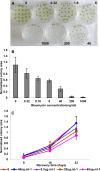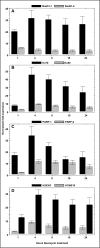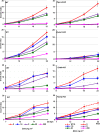The Transcriptional Response to DNA-Double-Strand Breaks in Physcomitrella patens
- PMID: 27537368
- PMCID: PMC4990234
- DOI: 10.1371/journal.pone.0161204
The Transcriptional Response to DNA-Double-Strand Breaks in Physcomitrella patens
Abstract
The model bryophyte Physcomitrella patens is unique among plants in supporting the generation of mutant alleles by facile homologous recombination-mediated gene targeting (GT). Reasoning that targeted transgene integration occurs through the capture of transforming DNA by the homology-dependent pathway for DNA double-strand break (DNA-DSB) repair, we analysed the genome-wide transcriptomic response to bleomycin-induced DNA damage and generated mutants in candidate DNA repair genes. Massively parallel (Illumina) cDNA sequencing identified potential participants in gene targeting. Transcripts encoding DNA repair proteins active in multiple repair pathways were significantly up-regulated. These included Rad51, CtIP, DNA ligase 1, Replication protein A and ATR in homology-dependent repair, Xrcc4, DNA ligase 4, Ku70 and Ku80 in non-homologous end-joining and Rad1, Tebichi/polymerase theta, PARP in microhomology-mediated end-joining. Differentially regulated cell-cycle components included up-regulated Rad9 and Hus1 DNA-damage-related checkpoint proteins and down-regulated D-type cyclins and B-type CDKs, commensurate with the imposition of a checkpoint at G2 of the cell cycle characteristic of homology-dependent DNA-DSB repair. Candidate genes, including ATP-dependent chromatin remodelling helicases associated with repair and recombination, were knocked out and analysed for growth defects, hypersensitivity to DNA damage and reduced GT efficiency. Targeted knockout of PpCtIP, a cell-cycle activated mediator of homology-dependent DSB resection, resulted in bleomycin-hypersensitivity and greatly reduced GT efficiency.
Conflict of interest statement
Figures




Similar articles
-
RAD51 loss of function abolishes gene targeting and de-represses illegitimate integration in the moss Physcomitrella patens.DNA Repair (Amst). 2010 May 4;9(5):526-33. doi: 10.1016/j.dnarep.2010.02.001. Epub 2010 Mar 1. DNA Repair (Amst). 2010. PMID: 20189889
-
POLQ plays a key role in the repair of CRISPR/Cas9-induced double-stranded breaks in the moss Physcomitrella patens.New Phytol. 2019 May;222(3):1380-1391. doi: 10.1111/nph.15680. Epub 2019 Feb 5. New Phytol. 2019. PMID: 30636294
-
MRE11 and RAD50, but not NBS1, are essential for gene targeting in the moss Physcomitrella patens.Nucleic Acids Res. 2012 Apr;40(8):3496-510. doi: 10.1093/nar/gkr1272. Epub 2011 Dec 30. Nucleic Acids Res. 2012. PMID: 22210882 Free PMC article.
-
Mechanisms of DNA double strand break repair and chromosome aberration formation.Cytogenet Genome Res. 2004;104(1-4):14-20. doi: 10.1159/000077461. Cytogenet Genome Res. 2004. PMID: 15162010 Review.
-
Identification of genes involved in repair of DNA double-strand breaks in mammalian cells.Radiat Res. 1998 Nov;150(5 Suppl):S80-91. Radiat Res. 1998. PMID: 9806611 Review.
Cited by
-
SRS2 is required for MUS81-dependent CO formation in zmm mutants.PLoS Genet. 2025 Aug 7;21(8):e1011637. doi: 10.1371/journal.pgen.1011637. eCollection 2025 Aug. PLoS Genet. 2025. PMID: 40773506 Free PMC article.
-
Autopolyploidization affects transcript patterns and gene targeting frequencies in Physcomitrella.Plant Cell Rep. 2022 Jan;41(1):153-173. doi: 10.1007/s00299-021-02794-2. Epub 2021 Oct 12. Plant Cell Rep. 2022. PMID: 34636965 Free PMC article.
-
Manipulating alternative end-joining alters carbon-ion beam-induced genome mutation profiles in Arabidopsis thaliana.DNA Res. 2025 Jul 4;32(4):dsaf014. doi: 10.1093/dnares/dsaf014. DNA Res. 2025. PMID: 40448271 Free PMC article.
-
The loss of SMG1 causes defects in quality control pathways in Physcomitrella patens.Nucleic Acids Res. 2018 Jun 20;46(11):5822-5836. doi: 10.1093/nar/gky225. Nucleic Acids Res. 2018. PMID: 29596649 Free PMC article.
-
Genome Protection by DNA Polymerase θ.Annu Rev Genet. 2022 Nov 30;56:207-228. doi: 10.1146/annurev-genet-072920-041046. Epub 2022 Aug 26. Annu Rev Genet. 2022. PMID: 36028228 Free PMC article. Review.
References
-
- Kenrick P. Crane PR. The origin and early evolution of plants on land. Nature 1997;389: 33–39.
-
- Zimmer A, Lang D, Richardt S, Frank W, Reski R, Rensing SA. Dating the early evolution of plants: detection and molecular clock: analyses of orthologs. Mol. Genet. Genomics. 2007;278: 393–402. - PubMed
-
- Rensing SA, Lang D, Zimmer A, Terry A, Salamov A, Shapiro H, et al. The Physcomitrella genome reveals insights into the conquest of land by plants. Science. 2008;319: 64–69. - PubMed
-
- Schaefer DG, Zryd JP. Efficient gene targeting in the moss Physcomitrella patens. Plant J. 1997;11: 1195–1206. - PubMed
MeSH terms
Substances
LinkOut - more resources
Full Text Sources
Other Literature Sources
Molecular Biology Databases
Research Materials
Miscellaneous

